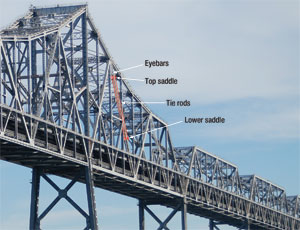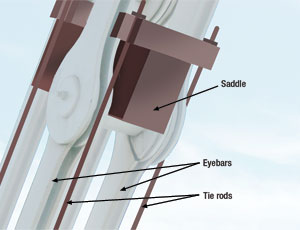As 280,000 daily vehicles resumed using the San Francisco-Oakland Bay Bridge on Nov. 2 after a six-day repair of a steel saddle that holds a cracked truss section in place, engineers and metallurgists were still investigating why the original Labor Day weekend fix failed so quickly.


The Oct. 27 failure occurred when a 5,000-lb crossbeam and steel connectors fell into afternoon traffic, causing one accident and a traffic jam. The pieces that fell were installed over Labor Day weekend under an emergency contract by Rancho Cordova, Calif.-based C.C. Myers Inc. The bridge had been closed to allow CCM to install a 288-ft detour ramp as part of the bridge’s $6.3-billion reconstruction. A routine inspection revealed a crack in a structural eyebar—a 2-in.-thick, chain-like steel member—in the cantilevered eastern span.
In the re-repair, North Highlands, Calif.-based MCM Construction Inc. replaced all four support rods, installed damping devices to keep the new ones in place and deepened connecting welds into structural welds. MCM also added straps to support the rods. The enhancements are based on the theory that vibrations from high winds caused the failure, says California Dept. of Transportation spokesman Bart Ney. “Tying off the rods will ensure that if there is a failure, pieces won’t fall down,” he adds.
The replacement pieces were fabricated in Sacramento and trucked to the site. Crews dealt with wind gusts of up to 50 mph as they worked carefully to remove debris and put the new steel in place, says Ed Puchi, MCM treasurer. Ney says the cost of the original repairs was less than $2 million and paid for with emergency funds. The current project will be paid for similarly, he says.
MCM was working on an unrelated contract to build the Oakland portion of the reconstruction. Puchi says his engineer happened to be on his way home, near the scene of the failure. Caltrans asked him to mobilize laborers, inspectors and rod tensioning specialists.
Crews worked nonstop all week, aligning the rod with the saddle and custom-grinding any areas where steel could potentially rub against steel. Particular attention was paid to where support bars pass through holes in the saddle. “We machined the seating surface to eliminate the potential of rubbing,” says Puchi.
Federal Highway Administration engineers provided support in an advisory capacity, says FHWA spokeswoman Nancy Singer. Caltrans crews and a peer-review team checked the fix. A full design load was gradually added, using stressing jacks. The repair failed the first stress test on Oct. 31 and finally passed on Nov. 2.
CCM had surprised many by installing the saddle brace while reopening the bridge with only a 90-minute delay. But federal inspectors never checked those repairs, says Ney. Caltrans inspectors did continue monitoring the fix and noted some vibration on support bars about 10 days before the Oct. 27 incident, said Dale Bonner, California Secretary of Business, Transportation and Housing, at an Oct. 29 press conference. Replacing the eyebar entirely would take many months and “may not solve the problem,” he said.
Metallurgists are testing the damaged pieces to determine if the failure was due to design, material quality or installation. Caltrans plans to increase inspections from every two years to every three months and will close two lanes each Saturday for inspections, as well.
Dan Baker, CCM project manager, says his firm will not be fined for the failure because the design was approved by Caltrans. Ney says the agency is “very happy with the performance of both contractors.”

Post a comment to this article
Report Abusive Comment